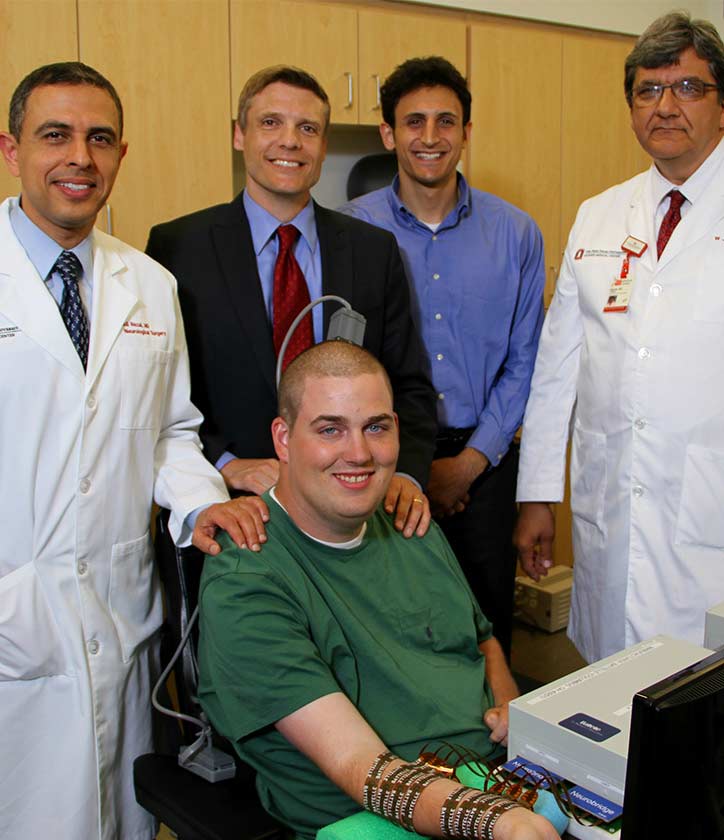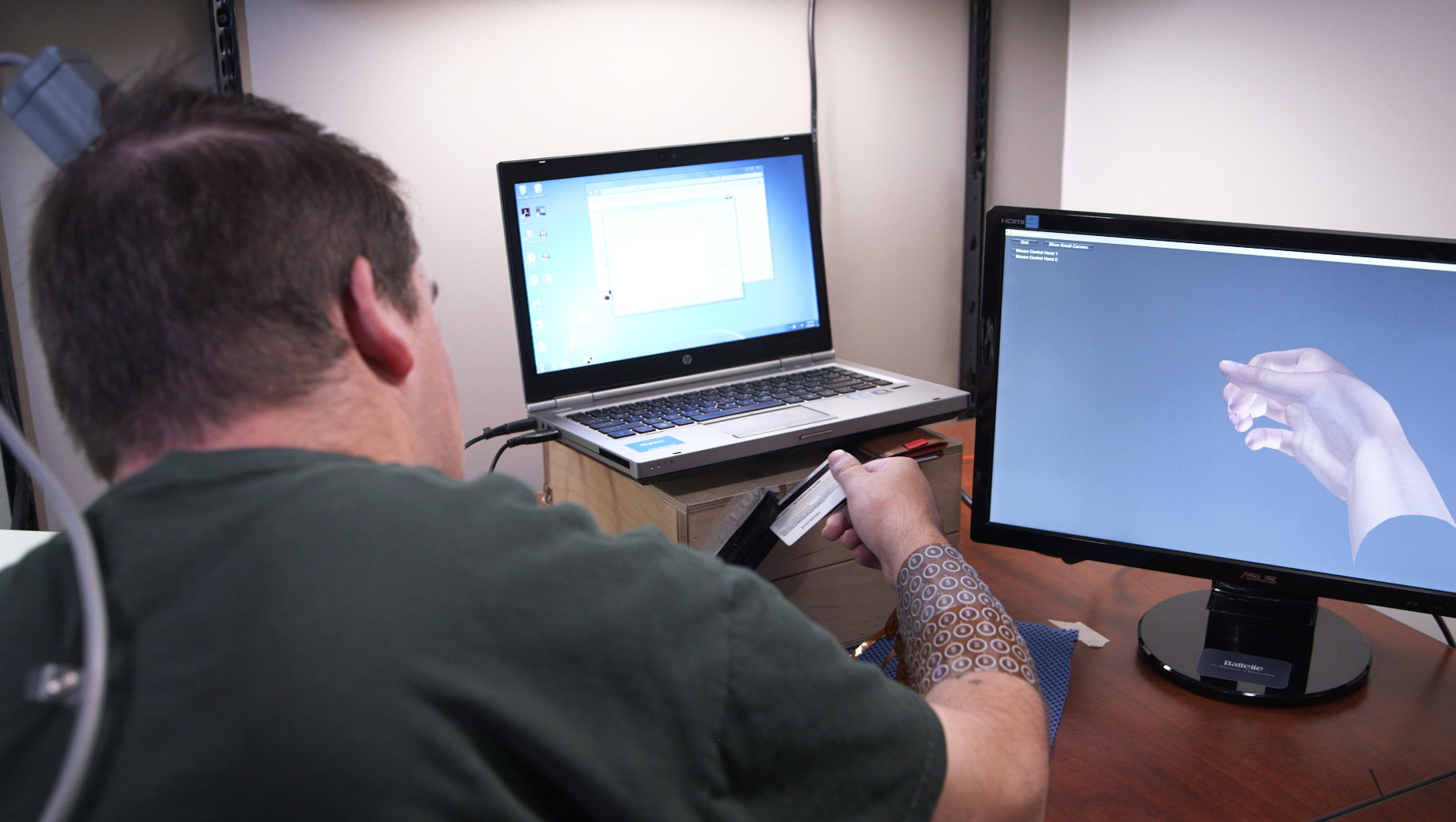Big data in healthcare goes far beyond EHR
Big data has applications in medtech that extend far beyond electronic health records. An analytics expert explains how data and algorithms have the potential to create a neuroassistive device to help paralyzed patients.

In 2014, Ian Burkhart became the first patient in the world to use neural bypass. The team included, from left, Ali Rezai MD, Chad Bouton, former researcher at Battelle, Nick Annetta, an electrical engineer at Battelle, Milind Deogankar MBBS and Jerry Mysiw MD.
Marie Thibault, MD+DI July 14, 2016
When we think of big data in healthcare, our minds often jump to analysis of patient data in electronic health records or determination of the best therapies for a particular cancer patient.
But the realm of possibilities is even wider than that. As Stephanie Kute, manager of advanced analytics and health research at Battelle, pointed out in a recent interview, “The excitement of bringing wearables into the medical realm, there’s a lot of hesitation there, but there’s a lot of excitement about the potential that can be accomplished… [given] how rapidly technology changes, even something that can’t be realized now, but the potential is so huge that so many different kinds of people are interested in the conversation.” Kute spoke with MD+DI following an appearance at last month’s MD&M East Conference in New York City, where she discussed medical device applications for data analytics.
One clear example of the far-reaching potential for big data and data analytics is Battelle’s invention, the NeuroLife device. NeuroLife was designed for patients who have been paralyzed by a spinal cord injury. The technology includes a computer chip implanted in a patient’s brain, which is then linked to a stimulation sleeve worn on the patient’s limb. Battelle partnered with researchers and clinicians at Wexner Medical Center at The Ohio State University (OSU) to implant NeuroLife in the first patient, Ian Burkhart, who is paralyzed from the chest down.
Kute explained, “One area that’s a great intersection between big data and medical device is our Neurolife program. [Battelle is] analyzing and decoding the brain signals and translating those into motor movement of the individual fingers of his hand… Obviously, the amount of data that’s coming off a brain implant when you’re monitoring neurons in the brain and being able to translate that into an electrical signal that causes a mechanical movement, that is a lot of different kinds of data that has to get translated all within a tenth of a second in order to have it be a realistic solution for him to turn his thoughts into movements.”
NeuroLife was developed at Battelle and Chad Bouton, who was previously research leader at Battelle, and his team started working with the OSU clinicians about four years ago, according to the Wexner release. Bouton, who last year wrote about the transformational potential of NeuroLife and other technologies for MD+DI, is now at The Feinstein Institute for Medical Research.
The NeuroLife neural bypass technology gained fame earlier this year when the research findings were published in Nature. The authors wrote that the technology gave the paralyzed patient the ability to move his fingers, hand, and wrist. “Clinical assessment showed that, when using the system, his motor impairment improved from the fifth to the sixth cervical (C5–C6) to the seventh cervical to first thoracic (C7–T1) level unilaterally conferring on him the critical abilities to grasp, manipulate, and release objects.”

Ian Burkhart, paralyzed from his shoulders down, swipes a credit card with the help of the NeuroLife technology. Ohio State University/Batelle.
What that means in everyday movements is Burkhart was able to swipe a credit card, play a video game, pick up and pour out jars, and other motions that fill daily life. It marked the first time a paralyzed person could control his limb movement using thought.
There is an enormous amount of data that needs to be analyzed and translated to allow for real-time movements. Kute said that the Battelle team is very focused on the algorithms that allow for the transformation of the neural signal. “Being able to take lots of information, identify what are the peaks and valleys that are important from a brain signal perspective, and being able to translate that into the motion. That’s the data analytics side of the equation and then of course we have to couple that with the engineering in order to make the movement happen,” she explained.
Battelle has translated the technologies it helped create in the defense and transportation industries to fit healthcare needs. Kute said, “With transportation, we’re thinking about traffic patterns and being able to control traffic flow. There are lots of sensors involved, lots of data to be analyze, there are a lot of changing dynamics in that scenario, a lot of imaging and image analysis. You can imagine translating that into the medical imaging framework, translating that into lots of information being collected and processed. Those same kinds of techniques can be applied to wearable sensor data, medical imaging, electronic health records, being able to tie all that together and make sense of the multiple data frames at the same time.”
NeuroLife could potentially become an assistive device for patients who are paralyzed. Kute pointed out that the technology also allows for neuroplastic response, meaning the patient’s brain could begin to recover too. While initially designed for spinal cord patients, she noted that NeuroLife could potentially be useful for stroke patients. “[Stroke] is also an area where a lot of recovery is possible. This may be a short term solution that would allow a permanent recovery,” she said.
As futuristic as NeuroLife and many other young, big data-based technologies seem, Kute is impatient to see innovators and researchers try more earlier. While discussing the potential of data analytics in healthcare, she said, “I think the hardest part right now is to make it tangible and to just start doing it instead of talking about it. I think there’s a lot of talk and a lot of potential and a lot of possibility, but then on the flip side there’s concerns and challenges… We just need to be iterating and getting it out there, finding out what works, what doesn’t work, and really getting the ball rolling.”
Source Medical Device and Diagnostic Industry, MD+DI
| References |
Restoring cortical control of functional movement in a human with quadriplegia, Chad E. Bouton, Ammar Shaikhouni, Nicholas V. Annetta, Marcia A. Bockbrader, David A. Friedenberg, Dylan M. Nielson, Gaurav Sharma, Per B. Sederberg, Bradley C. Glenn, W. Jerry Mysiw, Austin G. Morgan, Milind Deogaonkar & Ali R. Rezai. Nature 533, 247–250 (12 May 2016) doi:10.1038/nature17435
| Reconnecting a paralyzed man’s brain to his body through technology | Chad Bouton | TEDxColumbus. This talk was given at a local TEDx event, produced independently of the TED Conferences. What if you were in an accident or had a stroke that left you paralyzed or without the ability to speak? Chad Bouton is an engineer and researcher who found himself in that situation after a traumatic brain injury and facing that very question. He is now helping to advance a technology called ‘neural bridging’ that forms an artificial neural bypass that could help the millions of people living with paralysis and other effects from stroke and spinal cord or brain injuries. This talk will describe the revolutionary research and development that is underway and you will meet the first paralyzed patient to move again with this type of technology. TEDx Talks. YouTube Nov 25, 2014 |
Also see
Meet the man behind a pair of moving paralyzed hands in New You
Hacking the Brain to Treat Paralysis Wexner Medical Center Neurological Institute, Ohio State University
Paralyzed man with breakthrough brain chip plays guitar video game, swipes credit card Wexner Medical Center Neurological Institute, Ohio State University
